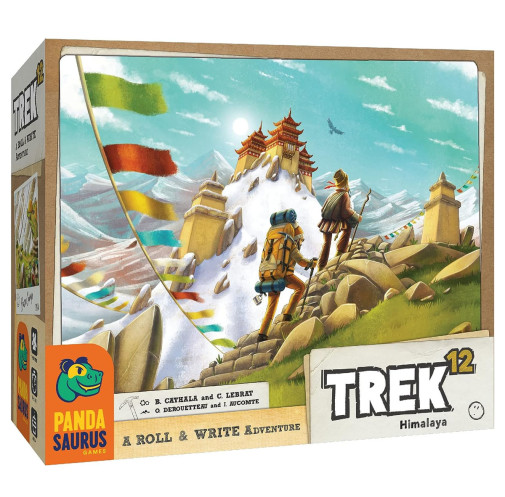We use cookies to make your experience better. To comply with the new e-Privacy directive, we need to ask for your consent to set the cookies. Learn more.
Trek 12: Himalaya Game
- Small parts. Not for children under 3 years.
Use your wits when you climb the Himalayas, map the area, set up your lines and navigate dangerous slopes. This is a roll & write game with three different adventure modes to play. There are separate manuals for each variation with all the necessary materials except for the writing implements of your choice. Mechanical pencils are ideal!
1. Trek Mode: This is the most basic version of the game and a good starting point for your adventure. There are two numbered dice and three different game pads with different patterns and challenges. The goal is to use the dice to choose a number each turn to fill in one of the circles on a game pad sheet to create groups of either lines of consecutive numbers or mapped zones of the same number. When all circles are filled, score for each number line or mapped area and subtract any penalties for numbers that are not part of either of these groups. The player with the most points wins!
2. Expedition Mode: You have mastered basic treks up the mountain and are ready for a bigger challenge. In this mode, you make 3 consecutive ascents with the goal of earning the most reputation stars to win. Start with the easiest trek, shuffle the assist cards and reveal the number of cards that reflect the number of people playing +3 (example, 7 cards in a 4-player game). Assist cards give players additional tools to make their journey a success. They are available when a player creates a new mapped zone using 0, 1 or 2 numbers. There are also exciting challenges with content envelopes that are opened for completing specific goals.
Beginning with the easiest ascent (Dunai, with the least number of reputation stars), start the first trek. Take turns playing as you did in Trek mode. At the end of each summit, total your scores. If a player earns the minimum number of points indicated on the score sheet to reach the summit, they earn the reputation stars in the first box. The player with the most points earns the stars in the second box – even if no player reached the summit. Quests 2 and 3 follow with greater challenges and larger scoring potential.
The first time a player earns an Ascent score, they write their name and score for that map in the Hall of Fame on the back of the Expedition Manual. In succeeding games, when players break the record for one of the three summits, they earn a bonus reputation star and write the new record in the Manual. If any player completes one of the challenges (there is a list of them in the manual), there is a corresponding envelope that adds new surprises for this expedition and all that follow. One envelope may be opened per ascent. Then, the game proceeds through the next two summits.
After the final and third ascent, reputation stars from all three ascents are added and the player with the most stars wins!
3. Solo Mode: After all the excitement of the first two game modes dies down, there is a solo mode and manual for those days when you wish to climb alone. Playing against an opponent named “Max”, set up a 2-player game. Choose from one of the three ascent sheets, give Max a trek sheet and be prepared to write for him (as he is invisible). Play and score points normally for your ascent in Trek Mode but each time you write a number on your sheet, Max writes the higher of the two dice values no matter which of the dice combinations you used. Scores are calculated as normal, but Max receives a solo bonus and takes no penalties. There are additional rules for playing the expedition mode in the manual.
The publisher’s recommended group size indicates 1-50 players but those in the game community who have taken these treks recommend an optimum number of 3-4 (1 in solo of course)! Playtime starts at 15 minutes for one ascent!
| Product Format: | Other |
|---|---|
| Brand: | Pandasaurus Games |
| Grades: | 3-AD |
| EAN/UPC: | 850029278207 |
| Length in Inches: | 6.25 |
| Width in Inches: | 7.875 |
| Height in Inches: | 2.875 |
| Weight in Pounds: | 2 |

